
|

|
| Use the text links for more information! |
 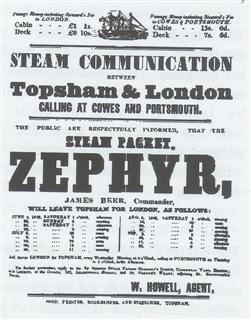 |
The Steam Packet is Topsham's second oldest pub (behind the Bridge
Inn). Amity Place behind the pub used to be known as Red Lion Court after the pub originally known as The Red Lion. The pub
is now named after "The Zephyr", which was a Steam Packet. The Zephyr conducted trips from Torquay to London via Topsham.
It called at places like Portsmouth on the way back. Another Steam Packet, the Ariadne started at Topsham and visited France
and the Channel Islands. These boats frequented the Steamer Quay which was further down river from the main town quay.
The side archway giving access to the court again suggests that the building was used as a Coaching Inn. One long thin lounge bar and a slightly more spacious lounge bar. Unfortunately this pub closed ion 8th November 2008 as a result of the "credit crunch", hopefully it will re-open in 2009 but as a trndy cafe bar. Again good beer. |
| Steamships
The first steamship was built in 1812 and was the 45ft Comet. Ships using both sail and steam appeared later but as steam engines became more reliable and improved, steam ships replaced sailing ships as the major means of sea transport. The first marine turbine powered ship, the 100ft Turbinia was demonstrated at the Spithead Naval Review in 1897, fascilitating the development of the high speed liners of the first half of the C20th. A steam Packet was and is a small coastal steamer used for carrying passengers and cargo. Most ships since 1960 have been diesel powered, the one notable exception being the QE2 (1968) which was initially fitted with steam turbines, although she subsequently converted to diesel. | Sea Plough
Out in the estuary in during the early 1970's, the Sea Plough laid a gas pipe line into the mud of the Exe. Topsham Quay was the base for this operation. The Red Branch (a Northern Irish tug) coordinated the Sea Plough, a crane barge, and a hopper barge. The pipeline was laid to supply gas to the South West of England from the newly discovered North Sea Gas fields. Going Dutch
Your next pub stop is up river along Ferry Road to the Passage House. The Strand (in the opposite direction), displays
some superb Dutch Gabled and Dutch style C17th merchants houses. Many other houses in Topsham incorporate dutch bricks
which were brought from Holland as ballast before filling the holds with cargo for the return journey. Of particular note
along The Strand is Shell House (1695) and No.10 Hannafords Quay (1670).
|
 |
Wixels is the large dutch gabled house along Ferry Road on your way to the Passage House Inn. It was originally a sail loft and later a coal shed, In 1920 it was converted into a house, the gables added and re-named "Wixels". The name actually comes from the building on the other side of the road. The Nail Cellars was as the name suggests originally a nail factory run by "Wigzell's Spiral Fluted Nail Company", hence Wixel's. |

|
The Passage House Inn keeps very good beer. You can sit out front overlooking
the river or go inside. Inside is better at low tide, believe me. The building is dated 1721, very similar in external
design to The Lighter. The clintele, the yacht crowd. Topsham sailing club was formed in 1885.
Outside just a little further down Ferry Road is the Ferry that could take you to the swingbridge (close to Topsham sidelock) on Exeter Canal. The Ferry has been here for centuries. The Sidelock was opened in 1837 and measured 88 ft by 25 ft, it was closed in 1976. Even further down Ferry Road is Follet Lodge, the former bithplace (1798) and home of Sir William Webb Follet who was
Attorney-General prior to his untimely death in 1845 aged 47. Around the corner on the site of a former workhouse, is the
Victorian, Clara Place built in 1841.
Early C15th. Exeter exported brightly coloured Kerseys to Spain while importing wine, figs, olive oil, soap, honey,
wax, almonds, figs, raisins, dates, oranges and marmalade. Portugal exported to Exeter a broadly similar line, but
also "grain" the precious scarlett dye used only for colouring the finest cloth.
There were also links with the low countries who brought "madder", a red dye, cheaper than"grain" and hops for the English
brewers who were still learning the art of brewing good hopped beer. To all of these places, Exeter via Topsham exported
cheap Devon wool cloth both coloured and white, supplemented by tanned hides, horses, lead, roofing tiles, tin and pewter
articles such as plates and mugs. The ships concerned in this trade were to some extent foriegn but mostly this trade was
carried out by English ships.
Your last pub stop is the Bridge Inn, but its a bit of a walk, use the map...15 minutes at most. In the meantime, I'll conclude the history of Topsham. |
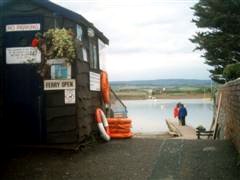 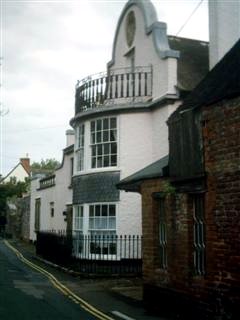  |
|
A remarkable growth in shipbuilding in the Exe Estuary took place at around this time (early C16th). There were Topsham
ships, the Mary Mongey (owned by Mathew Mongey), and the Mary Raliegh (owned by John Raliegh). Kenton and Cockwood also
has seagoing ships such as the Gabriel of Cockwood. All these ships regularly docked at Topsham together with ships from the
Dart Estuary, South Devon coast, Cornwall and Dorset, notably Lyme Regis. Coastal trade was also very important to Topsham
(and Exeter).
Shipbuilding is still seen in Topsham today, Trouts Boatyard has operated for over 100 years. The Salmon boat "Ruby" was built in Topsham in 1909 and fished the estuary for more than 50 years. There were also ships registered in inland towns such as Tiverton and Cullumpton, the Greenway ships were registered in Tiverton, a rapidly expanding clothing town. Cullumpton became a big rival to Tiverton in the late C15th, as a clothing producing centre, John Lane emulating John Greenway of Tiverton. |
All this trade came through Topsham and the Exe ports. Ships of Taunton began using Topsham to export clothes in preference
to Bridgewater by 1502. Exeter became the focal point of most industry and great industries thrived along the Exe.
See the Westquarter and Exe Island.
Between 1480 and 1510, the trade of Exeter and it's port of Topsham enjoyed an unprecedented boom. By 1523/25, Exeter's population was 8000, this having doubled or perhaps trebled in the late C14th. In 1676, such Topsham men as Thomas Heath and Thomas Crispin exported 13000 cloths from Topsham in such ships as "The Olive Branch", "The Speedwell" and The "Golden Fleece". In 1538, the head of the Courtenay family (Earls of Devon) was Henry (Marquis of Exeter). He was executed for allegedly conspiring against the King (Henry VIII). His lands were confiscated and within 2 years, the City authorities of Exeter had tried to re-open the Exe to traffic at Countess Wear. These attempts were unsuccessful and in 1545 it was decided that a Canal should be built. Work began in 1563. The canal had little effect on the trade of Topsham at first but as it was extended and widened several times, trade gradually began to shift to Exeter rather than Topsham. When James Green made the final extension to the canal (finished 1827), Topsham began to suffer to a greater extent. The port however adapted by unloading ships onto smaller barges and lighters that could navigate the canal. The cloth trade had largely ceased by 1800. Topsham was also involved in sailing emmigrants to the new world. On June 12th 1712, "The Mary" arrived in Boston, Massachusetts from Topsham, as did "The Prosperity" on the same date. |
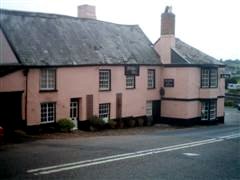 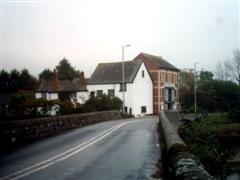 |
The Bridge Inn does keep some rather archaic opening times so you might
be unlucky. If you are lucky enough to gain access then the building is C16th with different sections of the building
completed at different times. It is built mostly of stone but the old brewhouse to the rear is of Devon
Cob. There is a malthouse and the remains of a hop-drying floor close
to a brewing chimney. Quite a building. The current owners' family have lived here for years. William John Gibbings moved
here from Clyst St George in 1897. Their website can be found through the Topsham Links page.
The Queen dropped by once in 1998. She was presented with a crate of 101 Ale from the Branscombe Vale Brewery and was on her way to visit the Lymstone Marines' Camp. Over the river are two buildings Fishers Bridge Mill, a 2 storey stone tied mill which worked until 1960. The adjacent 3 storey building was a brick steam mill. The bridge itself was constructed in 1750. Thats it. Unless you're staying in Topsham you can get a train or bus back to Exeter. Taxis are not to expensive, especially if theres a small group of you. |
| No it was a goat
Other things to do in Topsham when you've not had a skin-full include a visit to the Museum, located in in a group of C17th buildings overlooking the Estuary (along The Strand) and a walk along "Goat Walk". This is the pathway leading from the end of The Strand into the marshes and the estuary foreshore. Twitchers paradise, and not bad for a hang over relieving stroll. Branch Line
Between 1861 and 1958, a branch line from the Topsham to Exeter railway passed along what is now Holman Way to Topsham Quay.
The main track itself was converted to single track in 1978. The Victorian stationmaster's house and ticket office is
reputedly one of the finest examples of its type in the country. The building is now used as offices.
|
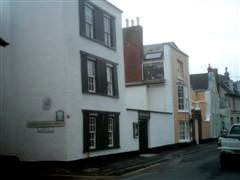  |
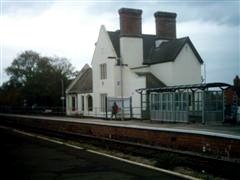
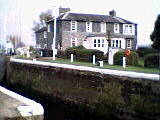 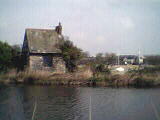 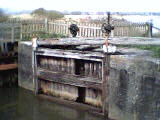 |
Green and the Turf
Another pub that is generally considered a Topsham Pub is the Turf Locks Hotel. You can get a Ferry from Topsham to Topsham sidelock on Exeter Canal and walk around 1.5 miles to the hotel which is now effectively a pub. Make sure you walk the right way. Turn left when you get off the Ferry. Great in the summer and the food and beer is excellent if a little on the expensive side. The crisps are monumentally expensive but very good. Barbeques in the summer are a speciality. The building was constructed by James Green around 1827 when he was making the final extensions to Exeter Canal but is showing signs of its age with subsidence causing uneven floors. As you can imagine, foundations for a Hotel on marshland require a fair amount of ingenuity. However this land has been artificially raised above the level of the marsh, so don't be too hard on our James. The new locks installed relatively recently are worth the walk. There are also some examples of old lock gates. Details of these are available by clicking on the Exeter Canal link above. Topsham sidelock and lock-house is also worth a look. This side-lock is in fact the youngest of the locks on the canal and are now falling into a state of disrepair and in my opinion are in a dangerous condition. Be careful when looking around. After the Canal was completed by James Green, Topsham boat owners petitioned for this side-lock to be installed to allow them access to the canal and thus help them mainatain some of their damaged trade. |
| Bygone Pubs
Many pubs as you know come and go, Topsham having once been a great port had its fair share. The Ship Aground became a bakery (next to Chapel Place), The Sun, a butchers shop and The Honest Heart a drill hall. The Seven Stars was a cider house located towards the southern end of the churchyard. There was also The Commercial (formerly known as The Lamb), The Ferry, The Topsham, The Five Sealers, Three Mariners, The Railway Inn, Ship Aground, The Ship, Ship in Dock and The Duke of Monmouth. The Welcome was not so welcome, and was well known for fisty cuffs on a Saturday night or any night you dared to visit. The Malt Scoop in White Street closed in the 1980's and there was also the Kings Head in Higher Shapter Street. More details of these and other old Topsham pubs are available in the "Old & Bygone Pubs" section of this website. Select "Topsham". Ray Girvan's excellent Topsham Ten website available through the Topsham Links page gives very good up to date pub descriptions and details of the beers available at all of the pubs mentioned above. |